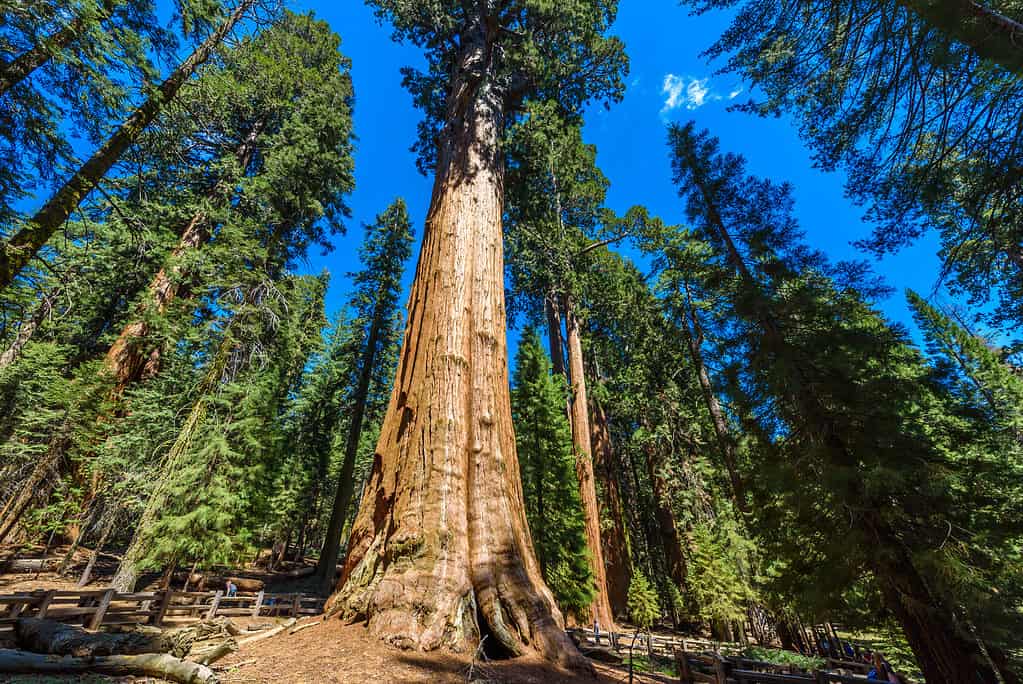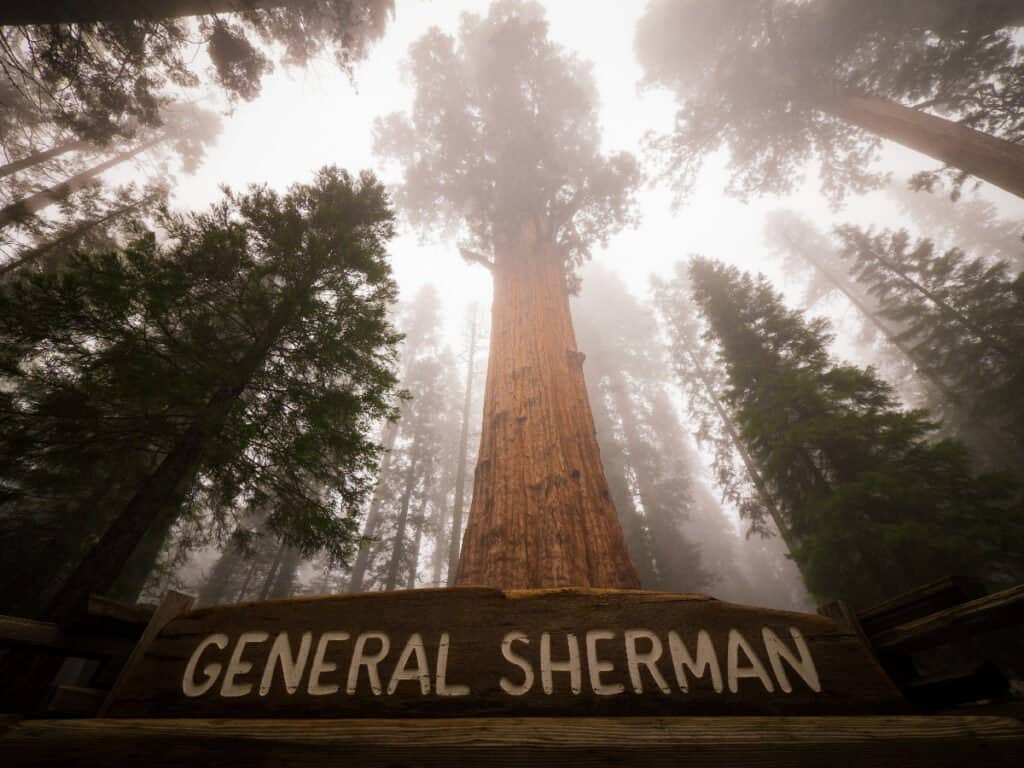Picture the largest living creature on earth; what do you see? Most people might conjure up an image of a blue whale. This makes sense, given that the blue whale ranks as the largest animal not just today but in Earth’s history. These giant mammals can measure around 100 feet long and weigh upwards of 300,000 pounds. That said, even these mammoth creatures pale in comparison to the largest living individual organisms in the world: trees.
There are many huge trees of note all around the world. Located in Redwood National Park, California, the Hyperion measures 380 feet tall, making it the world’s tallest tree. Meanwhile, Arbole del Tule in Mexico ranks as the widest, with a circumference of 138 feet. Trees come in all shapes and sizes, from short and fat to tall and skinny. However, some trees defy belief with both their amazing height and width. Of these trees, one stands larger than the rest, dwarfing all of its competition with its incredible size.
In this article, you’ll learn about the world’s largest giant sequoia, General Sherman. We’ll cover its measurements, where it’s located, and the history of this amazing tree. Additionally, we’ll let you know how you can visit this incredible tree yourself and what to expect on the journey.

Located within Sequoia National Park in Tulare County, California, General Sherman ranks as the largest tree in the world.
©Simon Dannhauer/Shutterstock.com
General Sherman: The Biggest Tree in the World
Located within Sequoia National Park in Tulare County, California, General Sherman ranks as the largest tree in the world. Specifically, General Sherman resides within Giant Forest Grove. This area of the park contains numerous large sequoias, 5 of which rank among the 10 largest trees in the world. These giant, named trees include the Monroe tree, Franklin tree, Lincoln tree, and President tree. That said, General Sherman’s mass overshadows all the other trees in the grove. With a height of 275 feet and a diameter of 36 at its base, General Sherman contains a total trunk volume of 52,500 cubic feet.
While General Sherman ranks as the largest living single-stem tree, several trees measured larger according to historical records. For example, the Lindsey Creek tree possessed a total volume of 90,000 cubic feet, nearly twice the size of General Sherman. This massive California redwood grew in Fieldbrook, California until it fell down during a storm in 1905. Another well-known coast redwood, the Channel Creek Giant, also measured slightly larger than General Sherman. However, it also fell down during the 20th century, a victim of the logging industry.
General Sherman: Dimensions

General Sherman is a large tree named for a powerful man.
©zdenekkounovsky/Shutterstock.com
As long as they live, trees can continue to grow in size. Therefore, the longer a tree lives, the larger it can grow, at least theoretically. According to best estimates, General Sherman is between 2,200 and 2,700 years old. Despite its advanced age and already massive size, the tree continues to grow upward and outward. Every year it adds enough mass to create another tree measuring 60 feet tall.
Even its branches measure larger than most trees. In 2006, General Sherman lost one of its largest branches after it broke off. No one knows exactly why the branch fell, although some experts believe that it broke as a natural process to help protect the tree against bad weather. Upon measuring the fallen limb, scientists were amazed at its measurements. This single limb measured 6.6 feet in diameter and was nearly 98 feet long!
General Sherman’s measurements will continue to get bigger and bigger as time goes on. That said, let’s take a look at the current approximate dimensions of this superb sequoia.
| Height above Base | 274.9 feet |
| Circumference at Ground | 102.6 feet |
| Maximum Diameter at Base | 36.5 feet |
| Diameter 60 inches above Base | 17.5 feet |
| Diameter 180 inches above Base | 14 feet |
| Diameter of Largest Branch | 6.8 feet |
| Height of the First Large Branch above the Base | 130 feet |
| Average Crown Spread | 106.5 feet |
History of General Sherman
In the United States, many large trees share their names with historical figures. For example, the Franklin tree gets its name from Benjamin Franklin, the Lincoln tree from Abraham Lincoln, and the Monroe tree from James Monroe. General Sherman is no exception to this rule, as it is named in honor of Civil War general William Tecumseh Sherman. According to legends, naturalist James Wolverton named the tree in 1879. Wolverton served under Sherman during the war and named the tree in honor of his former commander.
That said, General Sherman did not always share its name with the infamous general. During the 1880s, a utopian socialist community known as the Kaweah Colony moved into the area around Sequoia National Park. The members of the community disapproved of Sherman’s role in the removal of Native American tribes from their land. So, they decided to rename the tree the Marx tree in honor of Karl Marx. However, the community dissolved just a few years later, in 1892. With its dissolution, General Sherman again became the name for the giant sequoia.

In 2021, a lightning strike caused a wildfire along the upland slope of Giant Forest Grove in Sequoia National Park. This fire, known as the KNP Complex Fire, threatened numerous sequoias in the park, including General Sherman.
©iStock.com/Sara Edwards
Conservation and Threats
Scientists first recognized General Sherman as the largest tree in the world back in 1931. Since then, conservationists and wildlife authorities have gone to great lengths to protect this amazing tree. The two greatest threats to General Sherman – and other giant trees – come from bad weather and wildfires. While humans have little control over the former problem, we are actively involved in the creation and solution of the latter.
In 2021, a lightning strike caused a wildfire along the upland slope of Giant Forest Grove in Sequoia National Park. This fire, known as the KNP Complex Fire, threatened numerous sequoias in the park, including General Sherman. Although giant sequoias can withstand heat better than smaller trees, thanks to their thick bark, large fires still pose a significant threat to giant sequoias. To protect General Sherman and other large trees, firefighters wrapped the tree in heat-resistant aluminum foil. They also dug firelines around the tree to reduce the risk of fire spreading too close to its base.
Visiting General Sherman
You can visit Giant Forest Grove and General Sherman year-round. Two different trails lead to the giant sequoia, both of which feature signs leading you to the tree. The main trail to the tree measures around half a mile and is mostly paved. That said, it does feature a few stairs. The trail runs downhill on the way to the tree and uphill on the return hike. People with disabilities who want to visit the tree are encouraged to park in a designated lot near Generals Highway. From this lot, you can access a wheelchair-accessible trail that runs straight to General Sherman. Alternatively, you can catch a shuttle to the trail, all of which accommodate wheelchairs. That said, the shuttles do not run year-round.

Once you check out General Sherman, take time to explore the other giant sequoias in the grove.
©arkanto/Shutterstock.com
Once you check out General Sherman, take time to explore the other giant sequoias in the grove. The two-mile-long Congress Trail starts near General Sherman and loops around the park. It provides visitors with a great opportunity to see numerous giant sequoias in one trip. While visitors in years past used to be able to walk right up to the trees, this is now discouraged. A shallow fence surrounds General Sherman and many of the other trees in the park. Authorities encourage visitors to remain on the paved trails to avoid damaging any wildlife in the park. Additionally, this can help protect you from accidents. While the paths are well-maintained, the same cannot be said for any areas off the paths. If you visit the park in winter, make sure to pay special attention to icy spots on the ground.
If you want to check out more giant sequoias, you can take the General’s Highway to the nearby Kings Canyon National Park. This park also contains its fair share of giant sequoias, such as the General Grant tree, the second-largest tree in the world.
Up Next…
- Giant Sequoia vs. Coast Redwood: What’s the Difference?
- The 5 Biggest and Oldest Redwood Trees
- The 5 Oldest Sequoia Trees Still Alive
The photo featured at the top of this post is © Nick Fox/Shutterstock.com
FAQs (Frequently Asked Questions)
What are the measurements of General Sherman?
With its height of 275 feet and a diameter of 36 at its base, General Sherman contains a total trunk volume of 52,500 cubic feet.
Where did General Sherman get its name?
In the United States, many large trees share their names with historical figures. For example, the Franklin tree gets its name from Benjamin Franklin, the Lincoln tree from Abraham Lincoln, and the Monroe tree from James Monroe. General Sherman is no exception to this rule, as it is named in honor of Civil War general William Tecumseh Sherman. According to legends, naturalist James Wolverton named the tree in 1879. Wolverton served under Sherman during the war and named the tree in honor of his former commander.
Thank you for reading! Have some feedback for us? Contact the AZ Animals editorial team.







